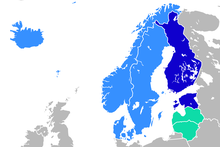Nordic-Baltic Eight (NB8) is a regional co-operation format that includes Denmark, Estonia, Finland, Iceland, Latvia, Lithuania, Norway, and Sweden. Under NB8, regular meetings are held of the Baltic and Nordic countries' Prime Ministers, Speakers of Parliaments, Foreign Ministers, branch ministers, Secretaries of State and political directors of Foreign Ministries, as well as expert consultations where regional issues and current international topics are reviewed.[2]
History
[edit]Historically, the countries of the region have been interlinked and interacted for centuries, with mutual trade being the decisive factor facilitating this interaction. The most profound bond, however was created during the 1990s.
The Nordic Council first contacted Baltic parliamentarians in around 1989. Official co-operation began in November 1991, when the Nordic Council attended the inaugural meeting of the Baltic Assembly in Tallinn. A formal co-operation agreement between the Nordic Council and the Baltic Assembly was signed in 1992.[3]
The Nordic countries were amongst the strongest supporters of the Baltic countries' independence and later they were the first to open their borders, introducing visa-free regimes with the Baltic countries.[4]
When Baltic countries regained their independence and during their integration into the European and transatlantic structures, they were strongly supported by their Nordic neighbors. The Nordic-Baltic co-operation took place in various levels: networking and cooperation were established among politicians, civil servants and civil societies. The Nordic countries actively assisted the Baltic countries in their preparations for integration into the European Union and NATO.[4]
Named as 5+3 in the beginning of cooperation (five Nordic countries plus three Baltic States), the format changed its name and scope of cooperation. During the meeting of the Ministers of Foreign Affairs of the Baltic States and Nordic Countries on 30 August 2000 in Middelfart (Denmark), the Ministers decided that the meetings of the Ministers of the Baltic States and Nordic Countries will be called NB8.[5]
Nordic–Baltic countries today
[edit]
The Nordic–Baltic community is one of the three main communities in Northern Europe: these are Nordic, Baltic and Baltic Sea Region.[6]
The Nordic–Baltic region has some 33 million inhabitants, and a combined GDP of close to $2.0 trillion,[7] which makes it the tenth-largest population and fifth-largest economy in Europe. Furthermore, the region features relatively low levels of corruption; with the Nordic countries being some of the least corrupt countries in the world. Also, the countries of the region place well in various international freedom rankings, with several of the states at the absolute top. The Nordic–Baltic countries also do well in surveys that measure the ease of doing business and creating new companies. The Human Development Index places many of the countries in the region among the most developed in the world.[8]
The Nordic–Baltic region is diverse, with a wealth of natural and cultural heritage, communities, destinations and resources. The region hosts a total of 42 World Heritage sites that are experiencing increasing pressures from tourism.[9] The Baltic states are described as three fascinating states that have glorious beaches along an extensive coastline, medieval old towns, and beautiful natural scenery, whereas the Nordic countries own spectacular scenery of mountains, lakes, archipelagos, glaciers, geysers, forests, waterfalls and volcanoes. There is much wilderness, including extensive arctic tundra.
沒有留言:
張貼留言